technical specifications FORD C MAX 2013 Owners Manual
[x] Cancel search | Manufacturer: FORD, Model Year: 2013, Model line: C MAX, Model: FORD C MAX 2013Pages: 552, PDF Size: 8.55 MB
Page 8 of 552
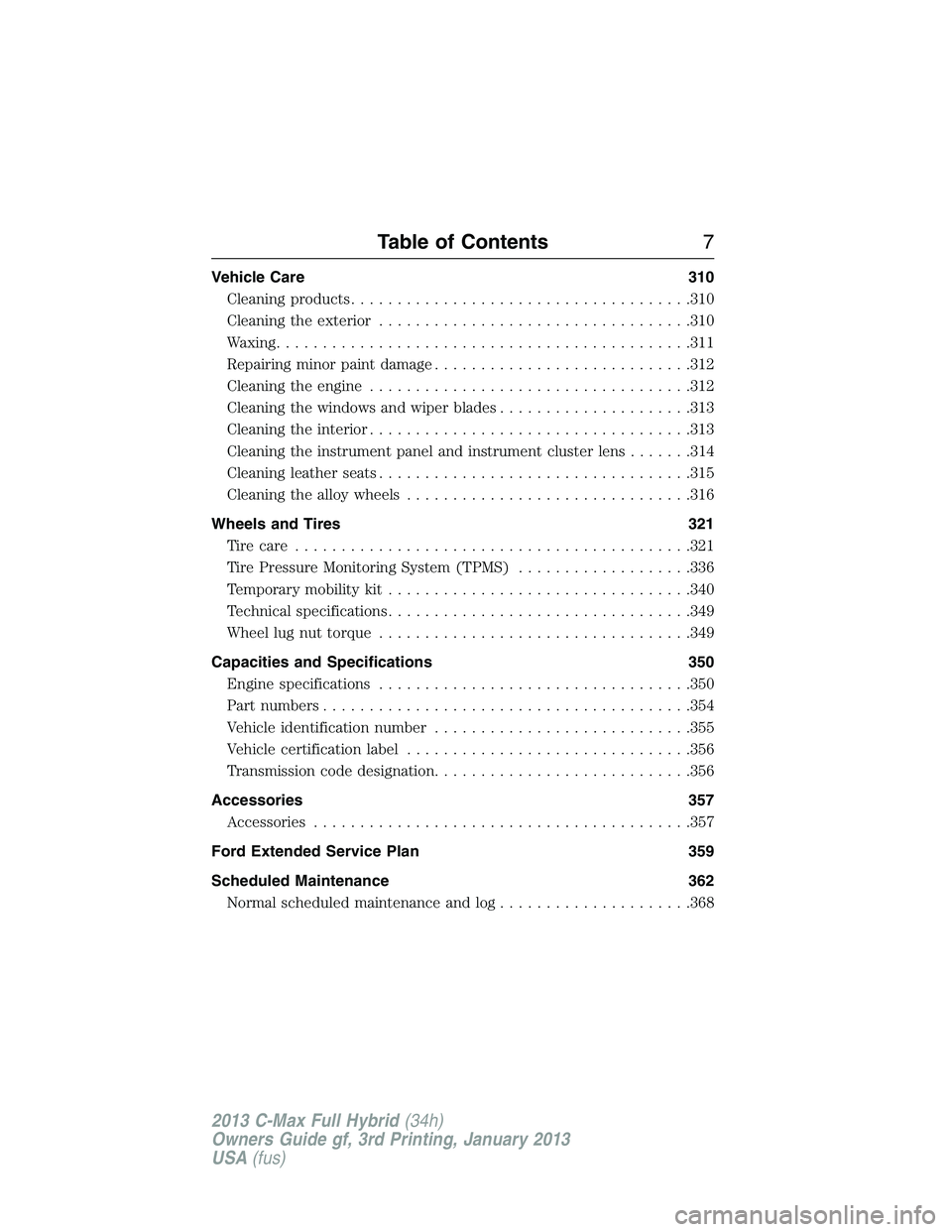
Vehicle Care 310
Cleaning products.....................................310
Cleaning the exterior..................................310
Waxing.............................................311
Repairing minor paint damage............................312
Cleaning the engine...................................312
Cleaning the windows and wiper blades.....................313
Cleaning the interior...................................313
Cleaning the instrument panel and instrument cluster lens.......314
Cleaning leather seats..................................315
Cleaning the alloy wheels...............................316
Wheels and Tires 321
Tire care...........................................321
Tire Pressure Monitoring System (TPMS)...................336
Temporary mobility kit.................................340
Technical specifications.................................349
Wheel lug nut torque..................................349
Capacities and Specifications 350
Engine specifications..................................350
Part numbers........................................354
Vehicle identification number............................355
Vehicle certification label...............................356
Transmission code designation............................356
Accessories 357
Accessories.........................................357
Ford Extended Service Plan 359
Scheduled Maintenance 362
Normal scheduled maintenance and log.....................368
Table of Contents7
2013 C-Max Full Hybrid(34h)
Owners Guide gf, 3rd Printing, January 2013
USA(fus)
Page 58 of 552
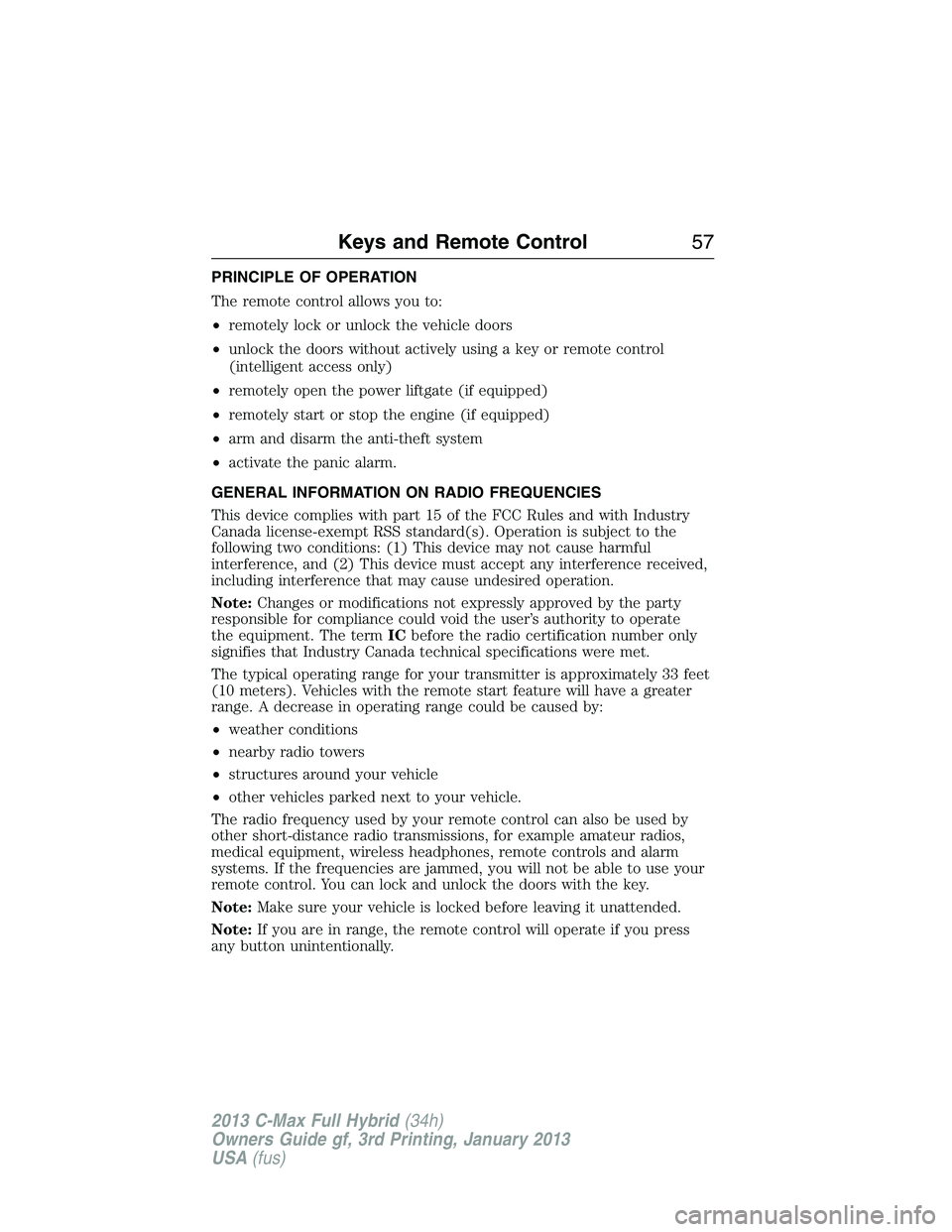
PRINCIPLE OF OPERATION
The remote control allows you to:
•remotely lock or unlock the vehicle doors
•unlock the doors without actively using a key or remote control
(intelligent access only)
•remotely open the power liftgate (if equipped)
•remotely start or stop the engine (if equipped)
•arm and disarm the anti-theft system
•activate the panic alarm.
GENERAL INFORMATION ON RADIO FREQUENCIES
This device complies with part 15 of the FCC Rules and with Industry
Canada license-exempt RSS standard(s). Operation is subject to the
following two conditions: (1) This device may not cause harmful
interference, and (2) This device must accept any interference received,
including interference that may cause undesired operation.
Note:Changes or modifications not expressly approved by the party
responsible for compliance could void the user’s authority to operate
the equipment. The termICbefore the radio certification number only
signifies that Industry Canada technical specifications were met.
The typical operating range for your transmitter is approximately 33 feet
(10 meters). Vehicles with the remote start feature will have a greater
range. A decrease in operating range could be caused by:
•weather conditions
•nearby radio towers
•structures around your vehicle
•other vehicles parked next to your vehicle.
The radio frequency used by your remote control can also be used by
other short-distance radio transmissions, for example amateur radios,
medical equipment, wireless headphones, remote controls and alarm
systems. If the frequencies are jammed, you will not be able to use your
remote control. You can lock and unlock the doors with the key.
Note:Make sure your vehicle is locked before leaving it unattended.
Note:If you are in range, the remote control will operate if you press
any button unintentionally.
Keys and Remote Control57
2013 C-Max Full Hybrid(34h)
Owners Guide gf, 3rd Printing, January 2013
USA(fus)
Page 288 of 552
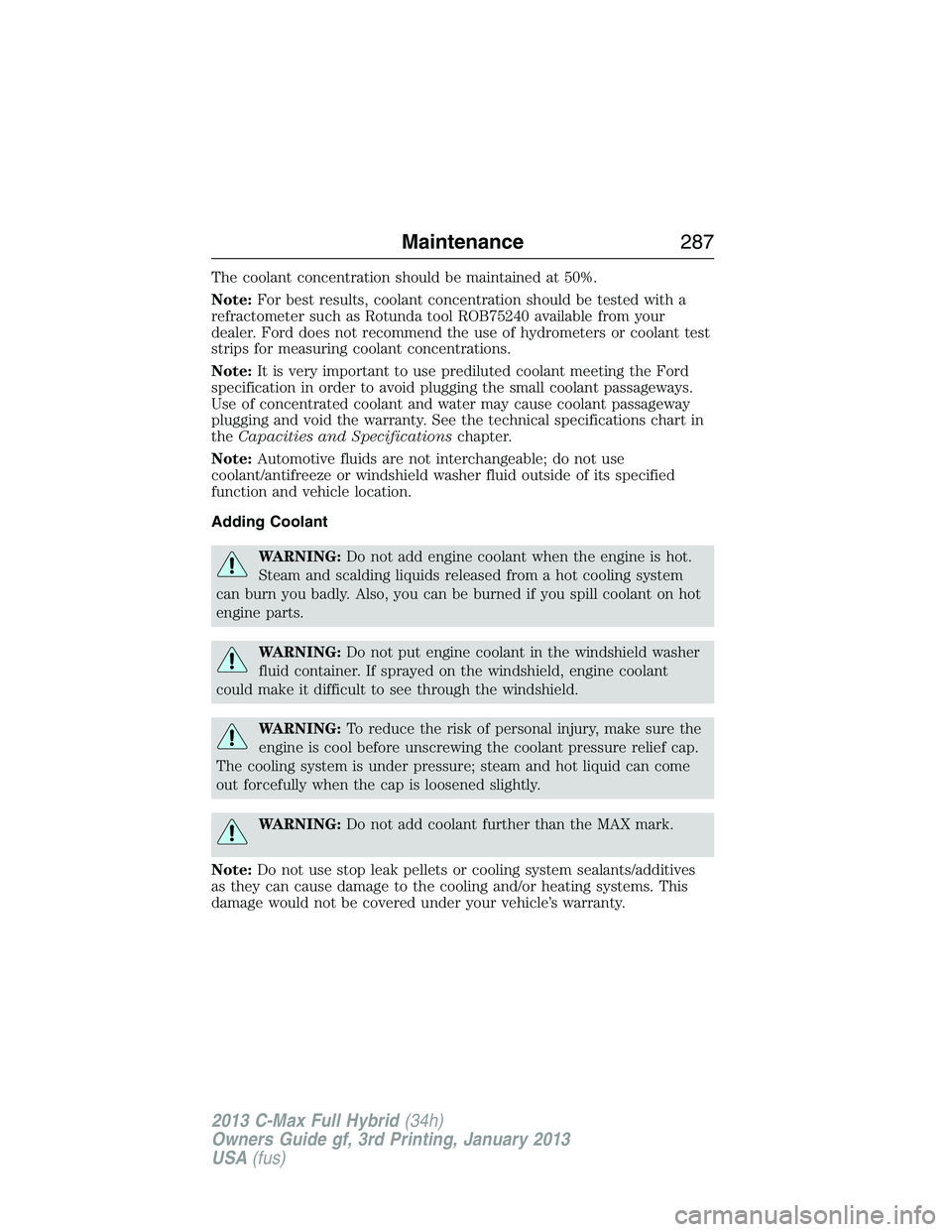
The coolant concentration should be maintained at 50%.
Note:For best results, coolant concentration should be tested with a
refractometer such as Rotunda tool ROB75240 available from your
dealer. Ford does not recommend the use of hydrometers or coolant test
strips for measuring coolant concentrations.
Note:It is very important to use prediluted coolant meeting the Ford
specification in order to avoid plugging the small coolant passageways.
Use of concentrated coolant and water may cause coolant passageway
plugging and void the warranty. See the technical specifications chart in
theCapacities and Specificationschapter.
Note:Automotive fluids are not interchangeable; do not use
coolant/antifreeze or windshield washer fluid outside of its specified
function and vehicle location.
Adding Coolant
WARNING:Do not add engine coolant when the engine is hot.
Steam and scalding liquids released from a hot cooling system
can burn you badly. Also, you can be burned if you spill coolant on hot
engine parts.
WARNING:Do not put engine coolant in the windshield washer
fluid container. If sprayed on the windshield, engine coolant
could make it difficult to see through the windshield.
WARNING:To reduce the risk of personal injury, make sure the
engine is cool before unscrewing the coolant pressure relief cap.
The cooling system is under pressure; steam and hot liquid can come
out forcefully when the cap is loosened slightly.
WARNING:Do not add coolant further than the MAX mark.
Note:Do not use stop leak pellets or cooling system sealants/additives
as they can cause damage to the cooling and/or heating systems. This
damage would not be covered under your vehicle’s warranty.
Maintenance287
2013 C-Max Full Hybrid(34h)
Owners Guide gf, 3rd Printing, January 2013
USA(fus)
Page 289 of 552
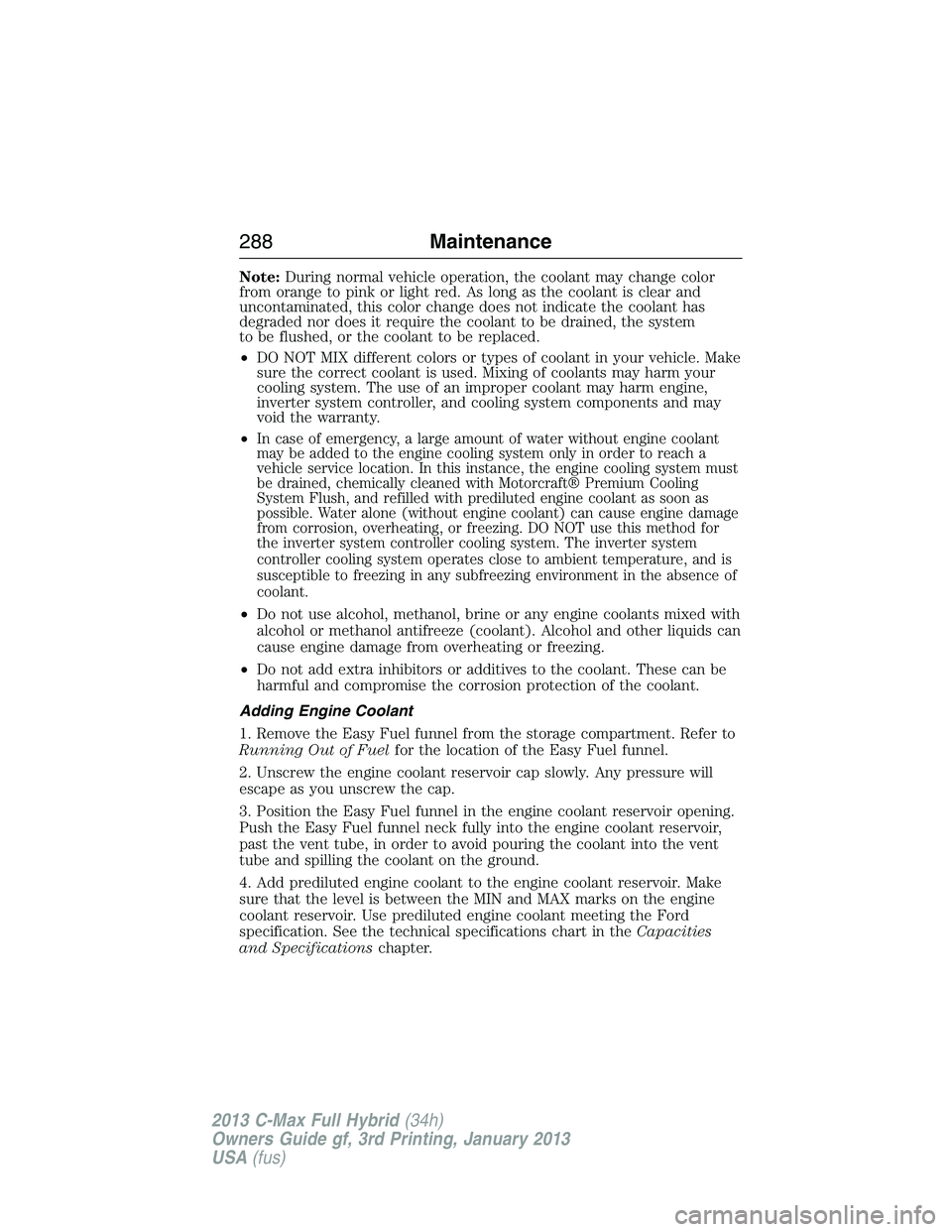
Note:During normal vehicle operation, the coolant may change color
from orange to pink or light red. As long as the coolant is clear and
uncontaminated, this color change does not indicate the coolant has
degraded nor does it require the coolant to be drained, the system
to be flushed, or the coolant to be replaced.
•DO NOT MIX different colors or types of coolant in your vehicle. Make
sure the correct coolant is used. Mixing of coolants may harm your
cooling system. The use of an improper coolant may harm engine,
inverter system controller, and cooling system components and may
void the warranty.
•
In case of emergency, a large amount of water without engine coolant
may be added to the engine cooling system only in order to reach a
vehicle service location. In this instance, the engine cooling system must
be drained, chemically cleaned with Motorcraft® Premium Cooling
System Flush, and refilled with prediluted engine coolant as soon as
possible. Water alone (without engine coolant) can cause engine damage
from corrosion, overheating, or freezing. DO NOT use this method for
the inverter system controller cooling system. The inverter system
controller cooling system operates close to ambient temperature, and is
susceptible to freezing in any subfreezing environment in the absence of
coolant.
•Do not use alcohol, methanol, brine or any engine coolants mixed with
alcohol or methanol antifreeze (coolant). Alcohol and other liquids can
cause engine damage from overheating or freezing.
•Do not add extra inhibitors or additives to the coolant. These can be
harmful and compromise the corrosion protection of the coolant.
Adding Engine Coolant
1. Remove the Easy Fuel funnel from the storage compartment. Refer to
Running Out of Fuelfor the location of the Easy Fuel funnel.
2. Unscrew the engine coolant reservoir cap slowly. Any pressure will
escape as you unscrew the cap.
3. Position the Easy Fuel funnel in the engine coolant reservoir opening.
Push the Easy Fuel funnel neck fully into the engine coolant reservoir,
past the vent tube, in order to avoid pouring the coolant into the vent
tube and spilling the coolant on the ground.
4. Add prediluted engine coolant to the engine coolant reservoir. Make
sure that the level is between the MIN and MAX marks on the engine
coolant reservoir. Use prediluted engine coolant meeting the Ford
specification. See the technical specifications chart in theCapacities
and Specificationschapter.
288Maintenance
2013 C-Max Full Hybrid(34h)
Owners Guide gf, 3rd Printing, January 2013
USA(fus)
Page 290 of 552
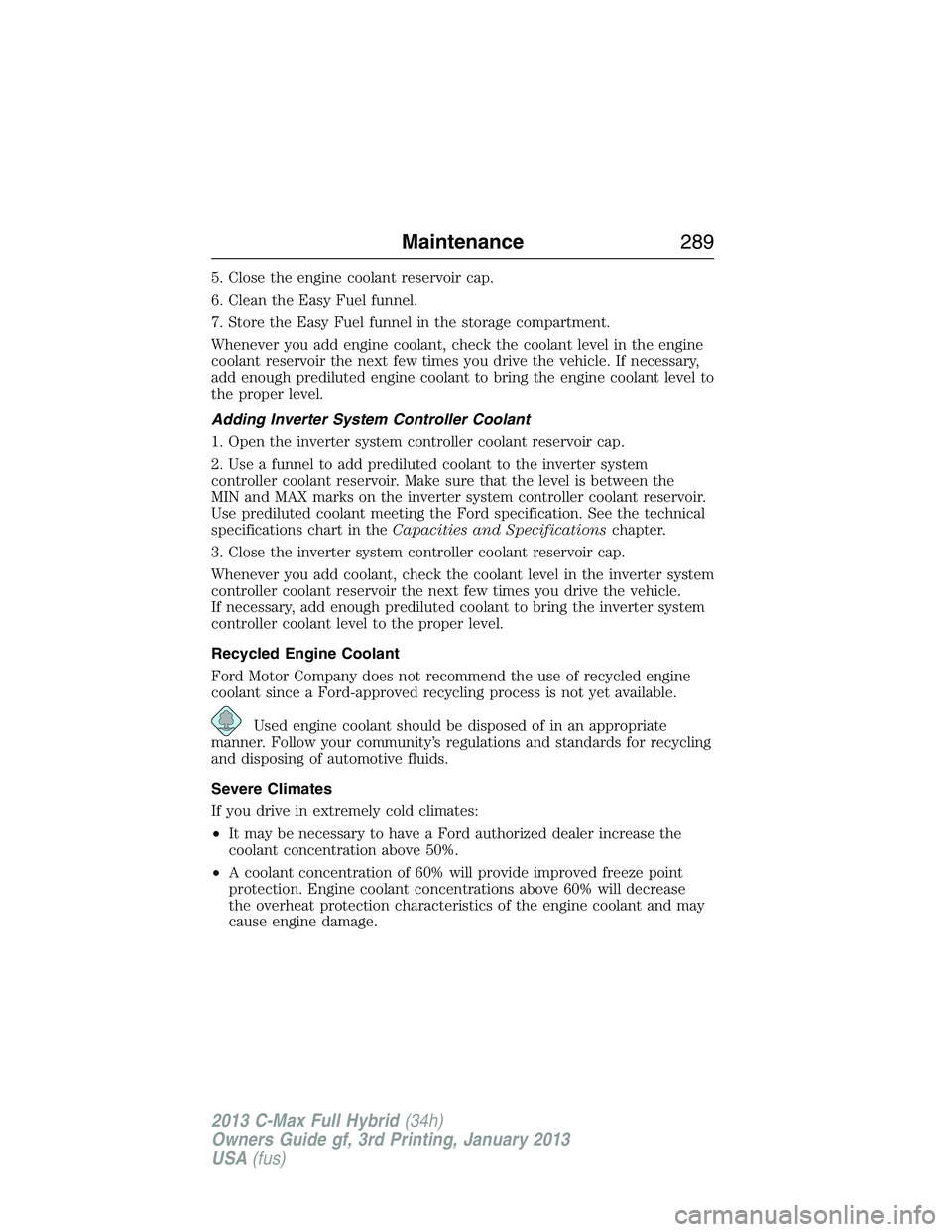
5. Close the engine coolant reservoir cap.
6. Clean the Easy Fuel funnel.
7. Store the Easy Fuel funnel in the storage compartment.
Whenever you add engine coolant, check the coolant level in the engine
coolant reservoir the next few times you drive the vehicle. If necessary,
add enough prediluted engine coolant to bring the engine coolant level to
the proper level.
Adding Inverter System Controller Coolant
1. Open the inverter system controller coolant reservoir cap.
2. Use a funnel to add prediluted coolant to the inverter system
controller coolant reservoir. Make sure that the level is between the
MIN and MAX marks on the inverter system controller coolant reservoir.
Use prediluted coolant meeting the Ford specification. See the technical
specifications chart in theCapacities and Specificationschapter.
3. Close the inverter system controller coolant reservoir cap.
Whenever you add coolant, check the coolant level in the inverter system
controller coolant reservoir the next few times you drive the vehicle.
If necessary, add enough prediluted coolant to bring the inverter system
controller coolant level to the proper level.
Recycled Engine Coolant
Ford Motor Company does not recommend the use of recycled engine
coolant since a Ford-approved recycling process is not yet available.
Used engine coolant should be disposed of in an appropriate
manner. Follow your community’s regulations and standards for recycling
and disposing of automotive fluids.
Severe Climates
If you drive in extremely cold climates:
•It may be necessary to have a Ford authorized dealer increase the
coolant concentration above 50%.
•A coolant concentration of 60% will provide improved freeze point
protection. Engine coolant concentrations above 60% will decrease
the overheat protection characteristics of the engine coolant and may
cause engine damage.
Maintenance289
2013 C-Max Full Hybrid(34h)
Owners Guide gf, 3rd Printing, January 2013
USA(fus)
Page 293 of 552
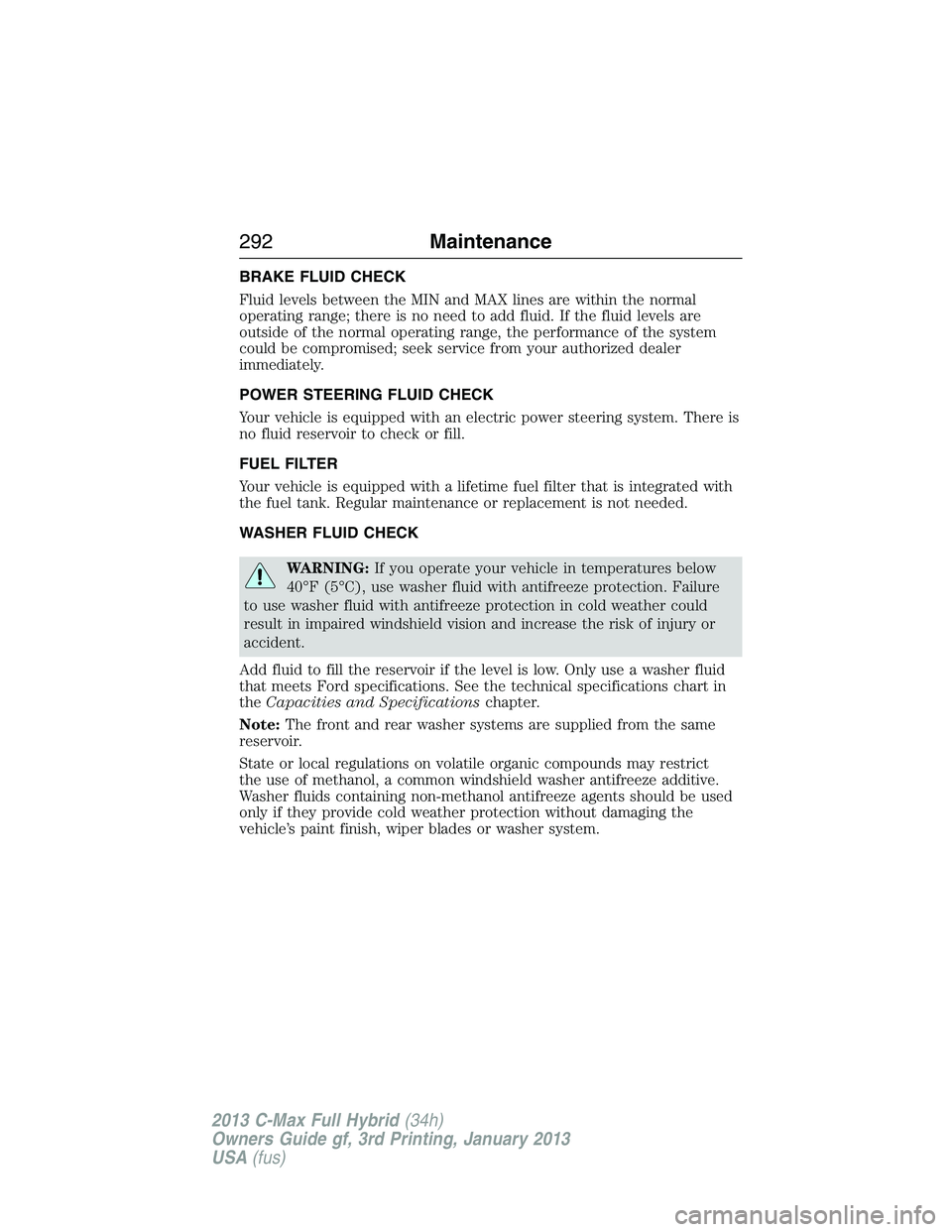
BRAKE FLUID CHECK
Fluid levels between the MIN and MAX lines are within the normal
operating range; there is no need to add fluid. If the fluid levels are
outside of the normal operating range, the performance of the system
could be compromised; seek service from your authorized dealer
immediately.
POWER STEERING FLUID CHECK
Your vehicle is equipped with an electric power steering system. There is
no fluid reservoir to check or fill.
FUEL FILTER
Your vehicle is equipped with a lifetime fuel filter that is integrated with
the fuel tank. Regular maintenance or replacement is not needed.
WASHER FLUID CHECK
WARNING:If you operate your vehicle in temperatures below
40°F (5°C), use washer fluid with antifreeze protection. Failure
to use washer fluid with antifreeze protection in cold weather could
result in impaired windshield vision and increase the risk of injury or
accident.
Add fluid to fill the reservoir if the level is low. Only use a washer fluid
that meets Ford specifications. See the technical specifications chart in
theCapacities and Specificationschapter.
Note:The front and rear washer systems are supplied from the same
reservoir.
State or local regulations on volatile organic compounds may restrict
the use of methanol, a common windshield washer antifreeze additive.
Washer fluids containing non-methanol antifreeze agents should be used
only if they provide cold weather protection without damaging the
vehicle’s paint finish, wiper blades or washer system.
292Maintenance
2013 C-Max Full Hybrid(34h)
Owners Guide gf, 3rd Printing, January 2013
USA(fus)
Page 350 of 552
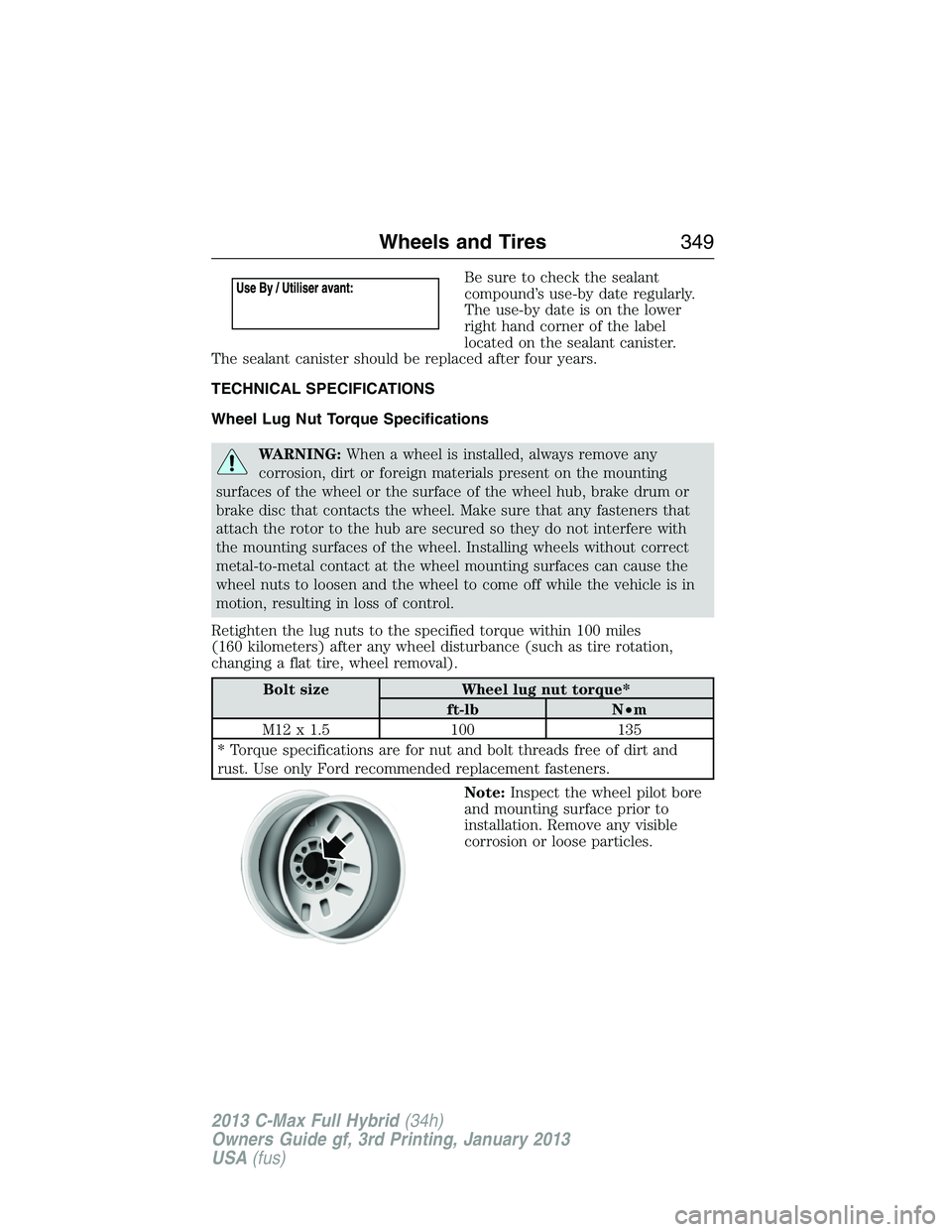
Be sure to check the sealant
compound’s use-by date regularly.
The use-by date is on the lower
right hand corner of the label
located on the sealant canister.
The sealant canister should be replaced after four years.
TECHNICAL SPECIFICATIONS
Wheel Lug Nut Torque Specifications
WARNING:When a wheel is installed, always remove any
corrosion, dirt or foreign materials present on the mounting
surfaces of the wheel or the surface of the wheel hub, brake drum or
brake disc that contacts the wheel. Make sure that any fasteners that
attach the rotor to the hub are secured so they do not interfere with
the mounting surfaces of the wheel. Installing wheels without correct
metal-to-metal contact at the wheel mounting surfaces can cause the
wheel nuts to loosen and the wheel to come off while the vehicle is in
motion, resulting in loss of control.
Retighten the lug nuts to the specified torque within 100 miles
(160 kilometers) after any wheel disturbance (such as tire rotation,
changing a flat tire, wheel removal).
Bolt size Wheel lug nut torque*
ft-lb N•m
M12 x 1.5 100 135
* Torque specifications are for nut and bolt threads free of dirt and
rust. Use only Ford recommended replacement fasteners.
Note:Inspect the wheel pilot bore
and mounting surface prior to
installation. Remove any visible
corrosion or loose particles.
Wheels and Tires349
2013 C-Max Full Hybrid(34h)
Owners Guide gf, 3rd Printing, January 2013
USA(fus)
Page 352 of 552
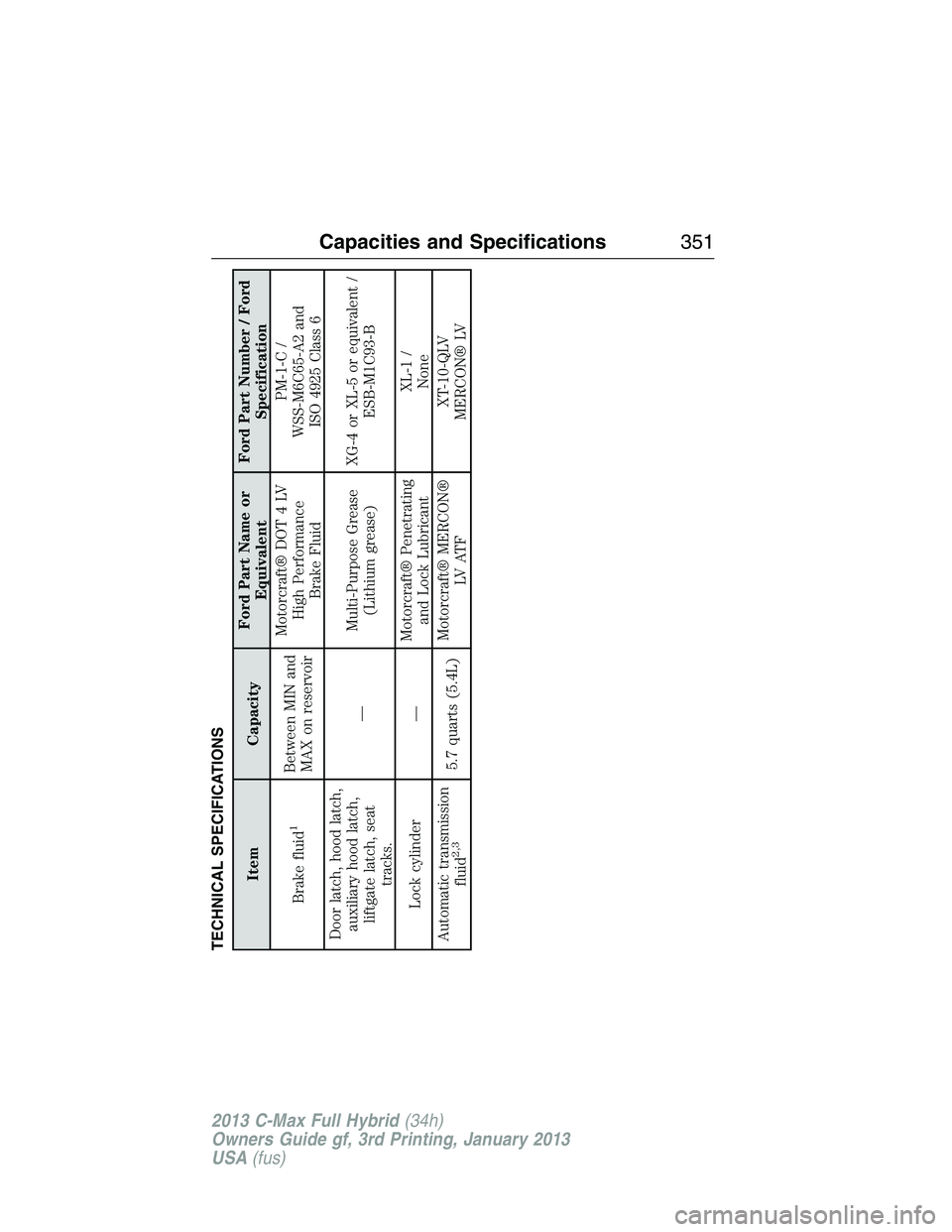
TECHNICAL SPECIFICATIONS
Item CapacityFord Part Name or
EquivalentFord Part Number / Ford
Specification
Brake fluid
1
Between MIN and
MAX on reservoirMotorcraft® DOT 4 LV
High Performance
Brake FluidPM-1-C /
WSS-M6C65-A2 and
ISO 4925 Class 6
Door latch, hood latch,
auxiliary hood latch,
liftgate latch, seat
tracks.—Multi-Purpose Grease
(Lithium grease)XG-4 or XL-5 or equivalent /
ESB-M1C93-B
Lock cylinder —Motorcraft® Penetrating
and Lock LubricantXL-1 /
None
Automatic transmission
fluid
2,3
5.7 quarts (5.4L)Motorcraft® MERCON®
LV AT FXT-10-QLV
MERCON® LV
Capacities and Specifications351
2013 C-Max Full Hybrid(34h)
Owners Guide gf, 3rd Printing, January 2013
USA(fus)
Page 544 of 552
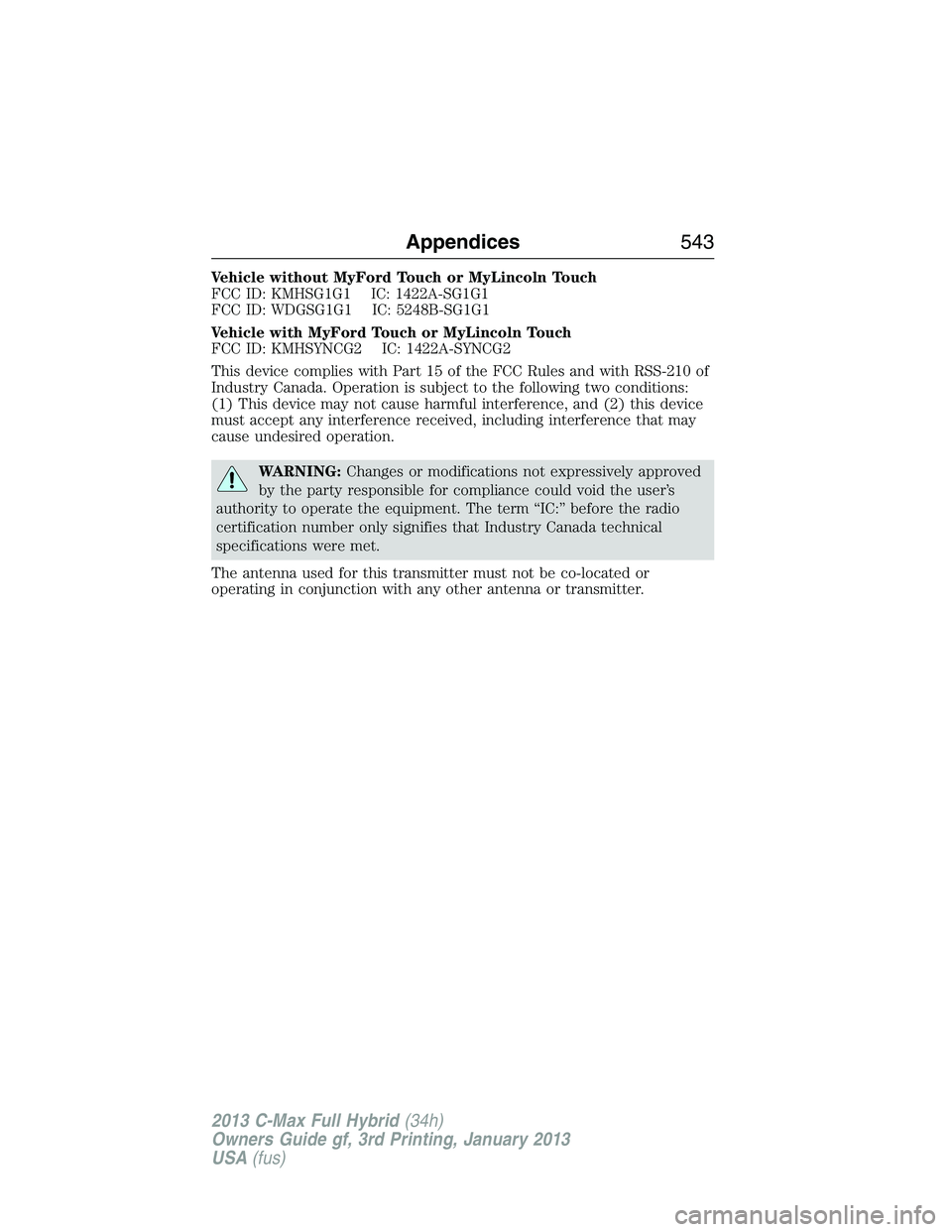
Vehicle without MyFord Touch or MyLincoln Touch
FCC ID: KMHSG1G1 IC: 1422A-SG1G1
FCC ID: WDGSG1G1 IC: 5248B-SG1G1
Vehicle with MyFord Touch or MyLincoln Touch
FCC ID: KMHSYNCG2 IC: 1422A-SYNCG2
This device complies with Part 15 of the FCC Rules and with RSS-210 of
Industry Canada. Operation is subject to the following two conditions:
(1) This device may not cause harmful interference, and (2) this device
must accept any interference received, including interference that may
cause undesired operation.
WARNING:Changes or modifications not expressively approved
by the party responsible for compliance could void the user’s
authority to operate the equipment. The term “IC:” before the radio
certification number only signifies that Industry Canada technical
specifications were met.
The antenna used for this transmitter must not be co-located or
operating in conjunction with any other antenna or transmitter.
Appendices543
2013 C-Max Full Hybrid(34h)
Owners Guide gf, 3rd Printing, January 2013
USA(fus)